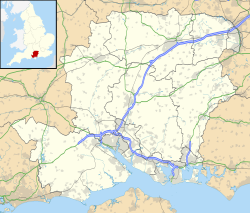| Winnall | |
|---|---|
(Clockwise from Top) The Golden Lion pub, houses on Winnall Manor Road, Flats off Winnall Manor Road | |
Location within Hampshire | |
| OS grid reference | SU492298 |
| District | |
| Shire county | |
| Region | |
| Country | England |
| Sovereign state | United Kingdom |
| Post town | WINCHESTER |
| Postcode district | SO23 |
| Dialling code | 01962 |
| Police | Hampshire and Isle of Wight |
| Fire | Hampshire and Isle of Wight |
| Ambulance | South Central |
| UK Parliament | |
Winnall is a northern suburb of Winchester, Hampshire, England, on the east bank of the River Itchen.
It is the location of the Winnall Moors nature reserve on the flood-plain of the Itchen and the University of Southampton's Erasmus Park hall of residence. Winnall is also the location of St Swithun's School, Winnal Primary school and Winchester's main industrial estate, occupying land between the A34 and the former Didcot, Newbury and Southampton Railway, by junction 9 of the M3.




